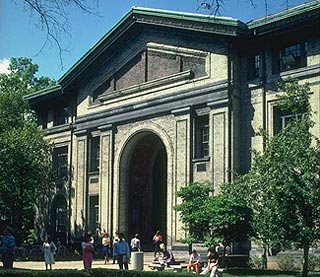In 1990, as a new 20-year-old Ph.D. student at CMU, I was fascinated by the Internet.

Working day and night in portable trailer 10 alongside Baker Hall, I added open-source software to the (shared) computer, converting it into a shared server for all of us who worked in there. Soon after, I added FTP, SSH, and Gopher servers. In 1993, after the Mosaic web browser was released, we added HTTP service as well.
Concerned about my undergraduate students who didn’t seem to have much ancillary reading under their belts, I studied the history of publishing in the United States. As I read about the 1979 Thor Power Tool Supreme Court decision, I learned that books (particularly contemporary fiction) had become much more expensive in the 1980s. Undergraduates didn’t fail to read because they were lazy; they failed to read because the U.S. making books much more expensive deterred young people from leisure reading. I tried to think about how that might be fixed.

I lobbied colleagues in the English Department and the CMU administration to fund a server which shared writings free online, and over the course of the 1990s the “English Server” became “EServer.org,” incorporated as a nonprofit, and became much more popular. We began to be added to popular “maps” of the Internet, and by the late 1990s were listed by Amazon’s web popularity tracker as the most popular arts and humanities website in the world.

Over the course of the 1990s, the EServer continued to grow, adding scholarly and authoritative collections in varied topics, such as 18th century literature, Thoreau’s philosophy, Antislavery literature, and popular culture studies. I directed the organization, which had an administrative board and contributors from across the United States and around the world.
In 2000 I took a faculty position at the University of Washington-Seattle, and the EServer came with me. In 2003 I was recruited to accept a faculty position at Iowa State University, and I brought the EServer with me to Ames, Iowa.

The EServer continued to grow throughout the 2000s, at its peak having over 227 people working on collections published from our site, and serving over 500,000 hits per day to over two million unique readers per month. We published multimedia, including audio and video podcasts, and interactive multimedia as well as all forms of writings.
But by the late 2010s, the EServer had failed to raise funding to support continued growth. Better-funded rival ventures seemed to be proceeding well. In 2017, in consultation with administrators at Iowa State, the EServer retired. It had made a valuable contribution to the early Internet, but its time has come to an end. I’m sad about that, but I understand the reasons.
I still miss the EServer, but it contributed (I believe significantly) to helping to create an Internet in which high-quality readings were available free of charge online. Low-cost writings and high-quality ebooks are now widespread online. I’m proud of the small contribution I feel the EServer made, from 1990 until 2017-18.
